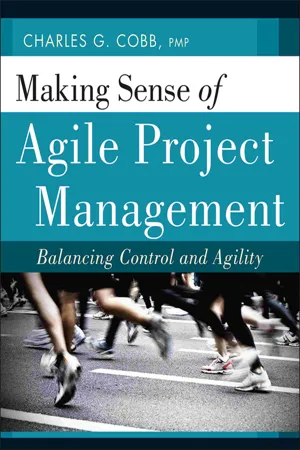
Making Sense of Agile Project Management
Balancing Control and Agility
Charles G. Cobb
- English
- ePUB (mobile friendly)
- Available on iOS & Android
Making Sense of Agile Project Management
Balancing Control and Agility
Charles G. Cobb
About This Book
Making Sense of Agile Project Management
Business & Economics/Project Management
The essential primer to successfully implementing agile project management into an overall business strategy
For a project to be truly successful, its management strategy must be flexible enough to adapt to dynamic and rapidly evolving business needs. Making Sense of Agile Project Management helps project managers think outside the box by presenting a deep exploration of agile principles, methodologies, and practices. Straying from traditional bureaucratic procedures that are rigidly defined, this book espouses a heavy reliance on the training and skill of collaborative, cross-functional teams to adapt the methodology to the problem that they are attempting to solve—rather than force-fitting a project to a particular methodology. Making Sense of Agile Project Management:
- Focuses on how agile project management fits with other more traditional project management models to provide a more effective strategy
- Includes many cases taken from real-world companies illustrating good and bad agile implementation
- Provides coverage that is balanced and objective with discussion of both agile and non-agile methodologies
Making Sense of Agile Project Management employs a straightforward approach that enables project managers to grasp concepts quickly and develop adaptable management tools for creating a vibrant and fluid business environment. By utilizing the principles laid out in this book, business managers and leaders will strengthen their ability to meet the risks and complexities of any individual project—and better understand how to blend the appropriate balance of control and agility into an overall business strategy.
Frequently asked questions
PART I
Overview
- “Agile” is an undisciplined process of simply writing code with no planning, no documentation, and no disciplined methodology for how it is done.
- The only way to be “agile” is to implement pure agile methodologies such as Scrum.
- At one end of the spectrum is the most extreme forms of traditional plan-driven, control-oriented methodologies like the Waterfall process; at the other end are pure agile approaches like Scrum, with nothing in between.
- Implementing an “agile” process requires just as much or more discipline as traditional approaches such as the Waterfall model, but it's a different kind of discipline. Rather than relying on rigidly defined and prescriptive methodologies, agile approaches rely much more heavily on the training and skill of collaborative, cross-functional teams to adapt the methodology to the problem that they are attempting to solve.
- Pure forms of agile like Scrum have many advantages, but they can be very difficult to implement and aren't necessarily appropriate for all business environments and projects. Many businesses require a balance of control and agility, which may be more suited to a hybrid approach.
- There are many ways companies can become “more agile” without necessarily going to the extreme of a pure agile approach, but it may take a more sophisticated approach to blend together the right combination of agile and non-agile methodologies and practices to craft a customized approach. The best approach is always to fit the methodology and practices to the business environment and problem you're trying to solve rather than force-fitting a project to a particular methodology, but doing that requires a much higher level of skill and it requires developing an understanding of the methodologies and practices at a deeper level.
Chapter 1
Introduction
Meaning of the Word “Agile”
- “The ability to create and respond to change in order to profit in a turbulent global business environment
- The ability to quickly reprioritize use of resources when requirements, technology, and knowledge shift
- A very fast response to sudden market changes and emerging threats, by intensive customer interaction
- Use of evolutionary, incremental, and iterative delivery to converge on an optimal customer solution
- Maximizing the business value with right-sized, just enough, and just-in-time processes and documentation”4
- At one end of the spectrum, there are approaches such as the traditional Waterfall methodology ...
Table of contents
- Cover
- Contents
- Title Page
- Copyright
- Preface
- Acknowledgments
- PART I: Overview
- PART II: Overview
- PART III: Appendices
- Index
- End User License Agreement